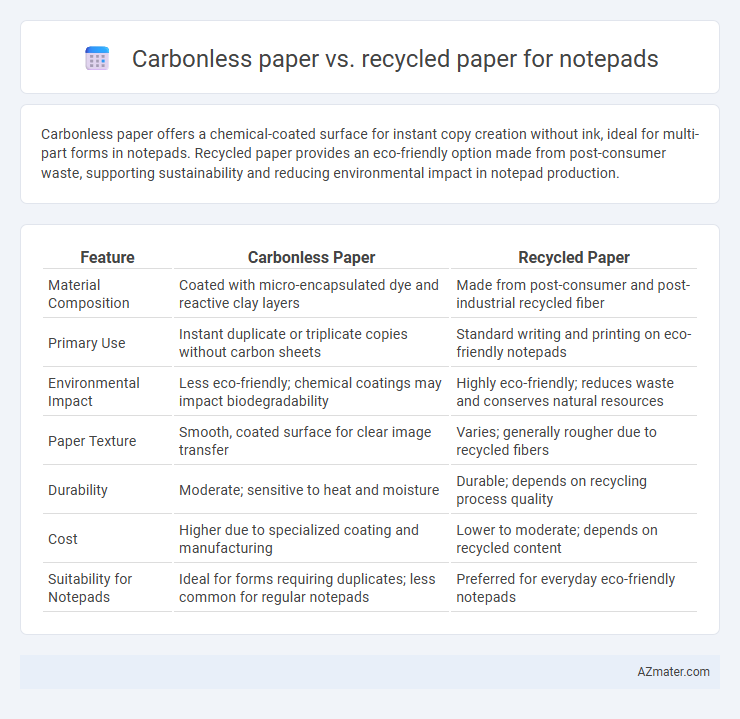Carbonless paper offers a chemical-coated surface for instant copy creation without ink, ideal for multi-part forms in notepads. Recycled paper provides an eco-friendly option made from post-consumer waste, supporting sustainability and reducing environmental impact in notepad production.
Table of Comparison
| Feature | Carbonless Paper | Recycled Paper |
|---|---|---|
| Material Composition | Coated with micro-encapsulated dye and reactive clay layers | Made from post-consumer and post-industrial recycled fiber |
| Primary Use | Instant duplicate or triplicate copies without carbon sheets | Standard writing and printing on eco-friendly notepads |
| Environmental Impact | Less eco-friendly; chemical coatings may impact biodegradability | Highly eco-friendly; reduces waste and conserves natural resources |
| Paper Texture | Smooth, coated surface for clear image transfer | Varies; generally rougher due to recycled fibers |
| Durability | Moderate; sensitive to heat and moisture | Durable; depends on recycling process quality |
| Cost | Higher due to specialized coating and manufacturing | Lower to moderate; depends on recycled content |
| Suitability for Notepads | Ideal for forms requiring duplicates; less common for regular notepads | Preferred for everyday eco-friendly notepads |
Introduction to Carbonless Paper and Recycled Paper
Carbonless paper uses micro-encapsulated dye or ink layers to transfer written information without carbon sheets, ideal for multi-part forms and instant duplicate copies. Recycled paper is produced from reclaimed fibers, reducing environmental impact by minimizing deforestation and energy use while maintaining durability and print quality. Both types serve distinct purposes in notepad production, balancing functionality with sustainability.
How Carbonless Paper Works in Notepads
Carbonless paper in notepads utilizes micro-encapsulated dye or ink on the back of the top sheet and a reactive clay coating on the front of the sheet below, enabling instant duplicate copies without carbon paper. Pressure from writing causes the microcapsules to break and transfer the image onto the sheet beneath, creating a clean and efficient copying process ideal for forms and receipts. Unlike recycled paper, which emphasizes environmental benefits, carbonless paper prioritizes functionality and clarity in multi-part form creation.
The Process of Making Recycled Paper Notepads
The process of making recycled paper notepads involves collecting and sorting post-consumer waste paper, which is then cleaned and de-inked to remove contaminants and inks. The resulting pulp is mixed with water and sometimes blended with virgin fibers for strength before being pressed and dried into sheets. These sheets are subsequently cut, bound, and finished into notepads, offering an eco-friendly alternative with reduced environmental impact compared to conventional carbonless paper.
Environmental Impact: Carbonless vs Recycled Paper
Carbonless paper contains chemical coatings that can release harmful substances during production and disposal, contributing to environmental pollution. Recycled paper notepads reduce deforestation and lower energy consumption by repurposing post-consumer waste, minimizing landfill impact and carbon footprint. Choosing recycled paper supports sustainable forestry practices and promotes a circular economy, making it a more eco-friendly option compared to carbonless alternatives.
Performance and Durability Comparison
Carbonless paper offers superior performance for notepads requiring instant duplicate copies without the need for carbon sheets, featuring high transfer clarity and sharp writing reproduction. Recycled paper emphasizes environmental sustainability but may have slightly lower whiteness and opacity, potentially affecting print contrast and durability over extended use. For durability, carbonless paper resists smudging and fading better, while recycled paper can be more prone to wear and tear due to shorter fiber lengths.
Cost Analysis: Which Is More Economical?
Carbonless paper typically costs more than recycled paper due to its special coating that enables instant duplicate copies without carbon sheets, increasing production expenses. Recycled paper is generally more economical as it leverages post-consumer waste, reducing raw material and manufacturing costs. For budget-conscious notepad production, recycled paper offers significant cost savings while maintaining acceptable quality.
Print Quality and Writing Experience
Carbonless paper offers superior print quality with clear, sharp impressions ideal for multi-part forms and ensures instant duplication without the need for carbon sheets. Recycled paper may show slight variations in texture and brightness, which can affect ink absorption and lead to less crisp print results. Writing on carbonless paper provides a smooth experience with reduced smudging, while recycled paper often has a coarser surface that can impact pen glide and overall writing comfort.
User Preferences and Industry Trends
Carbonless paper notepads are favored for instant duplicate creation without ink, appealing to businesses requiring quick record-keeping, while recycled paper notepads attract environmentally conscious users prioritizing sustainability. Industry trends indicate a growing demand for eco-friendly stationery, pushing manufacturers to increase recycled content in notepads. User preferences increasingly balance functionality with environmental impact, driving innovation in biodegradable and carbonless paper blends.
Practical Applications of Each Paper Type
Carbonless paper excels in creating instant duplicate copies without ink or carbon sheets, making it ideal for invoices, receipts, and multi-part forms in offices and retail environments. Recycled paper suits notepads aimed at eco-conscious consumers, providing a sustainable option for everyday note-taking, journaling, and office use while reducing environmental impact. Both paper types serve specific practical needs: carbonless paper for efficient copy generation and recycled paper for sustainability-focused writing products.
Choosing the Right Paper for Your Notepad Needs
Carbonless paper features micro-encapsulated dyes that create instant duplicates without ink, making it ideal for multi-part forms or receipts in a notepad. Recycled paper provides an eco-friendly option with a reduced environmental footprint, suitable for everyday writing and general note-taking. Choosing between these papers depends on the need for copy duplication versus sustainability priorities in your notepad usage.

Infographic: Carbonless paper vs Recycled paper for Notepad
 azmater.com
azmater.com